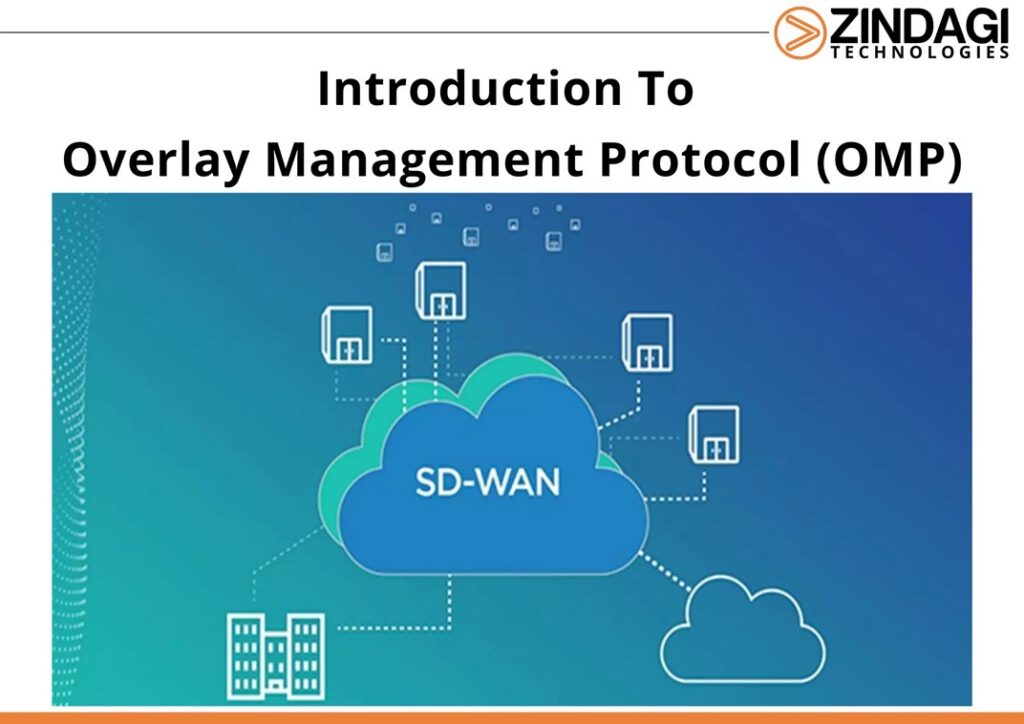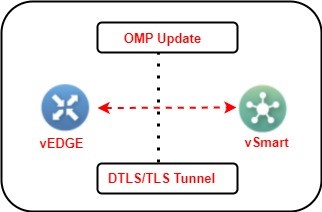Introduction To Overlay Management Protocol.

A new protocol known as OMP (Overlay Management Protocol) is included in Cisco’s Viptela SDWAN and serves as the overlay network’s nerve centre. The TLS or DTLS tunnels that are created between the vEdge router and the vSmart controller are used by the OMP protocol. The vSmart controllers and vEdge routers in the overlay network exchange routing, policy, and management data using the control protocol OMP.
On vEdge and vSmart, the OMP protocol, also known as Overlay Management Protocol, is already activated, you don’t need to actively enable it. The OMP protocol peering is formed on the system IPs of the two devices as soon as they authenticate each other and construct DTLS or TLS tunnels across them, and the exchange of routing information begins.

TLOCs (Transport Location)
A transport location is identified by TLOC routes. The WAN interface connects to a carrier or provider at these locations. Each TLOC consists of a System IP, Color, and Encapsulation in a three-tuple value.
System Ip – It is an IP address that is allocated to a device, much like a router ID, and it isn’t connected to any interface.
Color – It represents the type of WAN interface on the router.
Encapsulation – This can be either IPsec or GRE.
OMP advertises three types of routes: –
OMP Routes or vRoutes—-Through connected, static OSPF or BGP that is active on the site-local network, OMP gathers the routes from the local network at the site. The following attributes are then advertised along with these routes to the vSmart controller
TLOC- It indicates the vRoute’s subsequent hop. It resembles the BGP Next Hop characteristic in many ways. The three values in TLOC are “System IP, Color, and Encapsulation.”
- System IP is the address of the OMP speaker from which the OMP route originated.
- Link type is indicated by color.
- Transport tunnel encapsulation type
ORIGIN – It indicates the metric of the original route as well as the origin of the vRoute, i.e., whether the route came from BGP, OSPF, Connected or Static, etc.
ORIGINATOR – IP address that the route has spread from
PREFERENCE – If there are two identical OMP protocol routes, the route with the highest preference is chosen. The Standard is 0.
SERVICE – Service on the network connected to the OMP protocol route.
SITE-ID – Identifier for the location where the OMP route originates.
TAG – Optional that can be used to find a particular path and then act accordingly.
VPN – The VPN ID where the route has been spread.
TLOC ROUTES
TLOC Routes are the logical tunnel termination points that link to a transport network on vEdge routers. A three-tuple made up of the system IP address, link color, and encapsulation is used to identify and represent TLOC routes in a specific way (Generic Routing Encapsulation [GRE] or IPSec). TLOC routes additionally include properties such as TLOC private and public IP addresses, carrier, preference, site ID, tag, and weight in addition to the system IP address, color, and encapsulation. A BFD session must be active for a TLOC to be regarded as being in an active state on a specific vEdge.
SERVICE ROUTES
It represents the vEdge local-site network-connected services (firewall, IPS, application optimization, etc.) that are accessible to other sites for usage with service insertion. These routes also include VPNs; the VPN labels are transmitted using this update type to inform the vSmart controllers of the VPNs that are supported at a distant location.
An IT consulting company and a cybersecurity company which is leading in public and private sectors, Zindagi Technologies, has been the helping hand to many organizations in achieving their business goals. Having completed multiple IT projects and having a few under our sleeve, we plan to deliver only the best to the customer and fulfill all IT requirements.
We provide IT solutions like cyber security, cloud computing, VAPT, VoIP, etc. We can assist you with your network programs. You can ping us at +91-9773973971 and email us. You can also follow us on LinkedIn and read the latest updates.
Author
Lokesh Kumar
Associate Consultant
